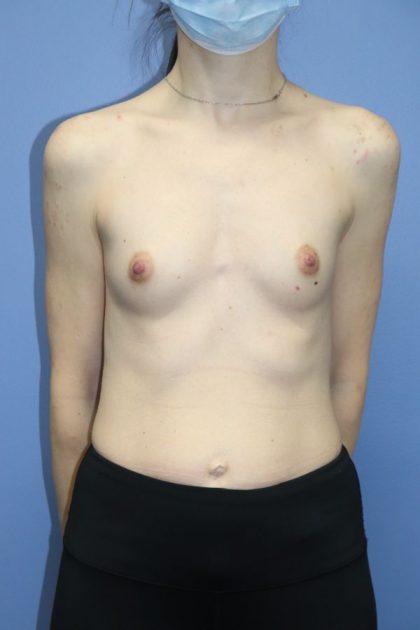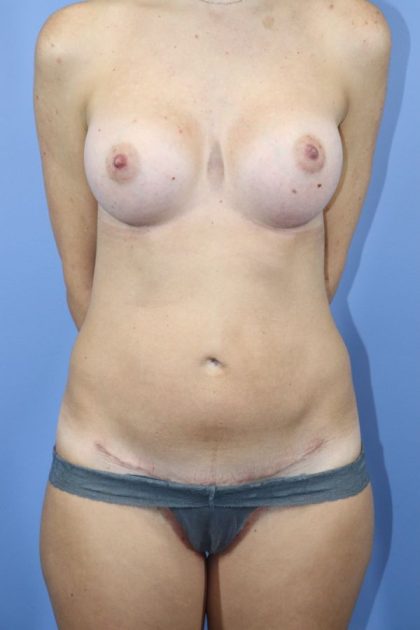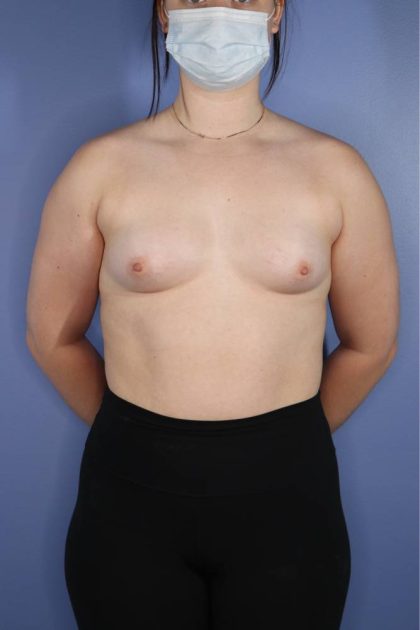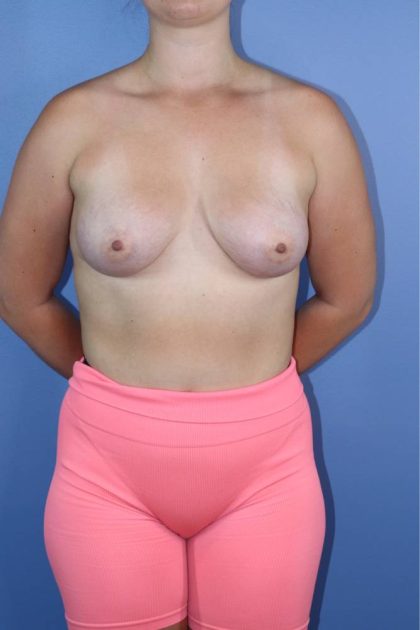Dense breast tissue refers to the composition of the breast, specifically the ratio of fibroglandular tissue to fatty tissue. When a woman has dense breasts, it means that she has more fibroglandular tissue in her breasts than fatty tissue. This can be determined through a mammogram, which is a specialized X-ray of the breast.
Before and After Photos
Having dense breast tissue is a common occurrence, with over 40% of women over 40 falling into the heterogeneously dense or extremely dense categories. (1) It is not something that can be felt or seen externally, but rather detected through imaging techniques such as mammography.
Dense breast tissue can affect breast cancer screening and detection. On a mammogram, fibroglandular tissue appears white, similar to tumors or other abnormalities that may indicate breast cancer. This can make it more challenging for radiologists to detect small tumors or lesions, as they can be masked by the dense tissue. Therefore, women with dense breasts are at a slightly higher risk of breast cancer, as the potential for missed or delayed diagnosis exists.
At Michael Howard Plastic Surgery, Dr. Howard understands the complexities of breast health and offers personalized consultations to address concerns related to breast density. Located in Chicago, our practice is dedicated to providing the highest standard of care and ensuring the well-being of our patients. To learn more or to schedule an appointment, please contact us at (224) 271-4250.
Contents
About Dense Breast Tissue
Dense breast tissue is not directly related to breast size or firmness. It is determined by the composition of the breast tissue itself. It is also important to note that having dense breast tissue does not mean you will develop breast cancer. It simply means that additional screening methods may be recommended to ensure early detection. Additional tests such as ultrasound or MRI may be suggested to complement mammography and provide a more comprehensive evaluation of breast health.
How is Breast Density Categorized?
Breast density is categorized into four levels:
- Category A: Predominantly Fatty
- Category B: Scattered Fibroglandular
- Category C: Heterogeneously Dense
- Category D: Extremely Dense
Predominantly fatty breasts have a higher amount of fatty tissue, while extremely dense breasts have a higher amount of fibroglandular tissue. Dense breasts are common. In fact, in women aged 40 or over, roughly 43% have dense breasts. (2)
How Do I Know If I Have Dense Breast Tissue?
While it is not possible to determine breast density through self-examination or physical observation alone, a mammogram is the most effective method for assessing breast density. During a mammogram, X-ray images are taken of the breasts, allowing radiologists to examine the composition of the breast tissue and determine its density.
If you have been notified by your radiologist that you have dense breast tissue, it is crucial to continue with regular breast cancer screenings, as recommended by your healthcare provider. This may include a combination of mammography, breast ultrasound, and other imaging techniques based on your individual risk factors and medical history. For patients with dense breast tissue who have already undergone a mastectomy due to breast cancer, there are options for breast reconstruction.
Dense Breast Tissue & Breast Reconstruction
Breast reconstruction offers an opportunity to restore the shape, symmetry, and confidence that may have been lost after mastectomy. There are various techniques available for breast reconstruction, including partial breast, reconstruction, also known as oncoplastic reconstruction, and autologous tissue transfer, also known as DIEP flap reconstruction, which uses the patient’s own abdominal tissue to create a natural-looking breast. Each approach has its own benefits and considerations, and the choice depends on factors such as individual anatomy, overall health, and personal preferences. As a renowned expert, and appointed member of the CDC’s Council on Breast Cancer in Young Women, Dr. Howard can determine which breast reconstruction surgery will be most beneficial to you.
Benefits of DIEP Flap Breast Reconstruction
At Michael Howard Plastic Surgery, we understand the profound impact that breast reconstruction can have on a person’s life. For individuals who have undergone mastectomy or experienced breast damage due to cancer treatment or other reasons, DIEP Flap breast reconstruction offers an effective solution that utilizes the patient’s own abdominal tissue to recreate a natural-looking breast mound.
Improved Cosmetic Results
With DIEP Flap reconstruction, patients can achieve natural-looking breasts that closely resemble their original shape and size. Dr. Howard’s expertise allows for meticulous shaping and contouring, resulting in aesthetically pleasing outcomes.
Improved Symmetry
Through precise surgical techniques, DIEP Flap reconstruction allows surgeons like Dr. Howard to carefully shape and mold the newly reconstructed breast to match the size, shape, and symmetry of the opposite breast. This significantly improves overall aesthetic balance and symmetry.
As DIEP Flap reconstruction uses the patient’s own tissue, there is no need for breast implants. This eliminates the potential risks associated with implants, such as leakage or rupture, providing peace of mind for patients.
Long-Lasting Results
The transferred abdominal tissue used in DIEP Flap reconstruction has a high chance of long-term survival. This means that patients can enjoy durable and lasting results, without the need for frequent revisions or touch-ups.
Improved Body Contouring
In addition to reconstructing the breast, DIEP Flap surgery can also result in a flatter abdomen, similar to the effects of a tummy tuck. This added benefit enhances body contouring, helping patients achieve a more balanced and harmonious figure.
Reduced Need for Revision Surgeries
Due to its high success rate, around 97%, (3) and natural outcomes, DIEP Flap breast reconstruction often eliminates the need for additional revision surgeries. Patients can avoid the inconvenience and potential risks associated with multiple procedures, saving time and resources.
Preservation of Abdominal Muscle Function
Unlike other types of flap reconstruction, DIEP Flap surgery spares the abdominal muscles, preserving their functionality. This minimizes post-operative pain and discomfort, allowing for a smoother recovery process.
Enhanced Psychological Well-Being
Restoring the breasts through DIEP Flap reconstruction can have a profound impact on a woman’s self-esteem, body image, and overall psychological well-being. By regaining confidence and experiencing emotional healing, patients can enjoy an improved quality of life.
Personal Consultation
A personal consultation with Dr. Michael Howard at his Lake Forest, Chicago, or Glenview location is an essential step if you are considering DIEP Flap breast reconstruction. This consultation offers numerous benefits that can help you make an informed decision and achieve the best possible outcome for your individual needs.
During your personal consultation, Dr. Howard will provide a detailed discussion about the potential aesthetic benefits of the DIEP Flap procedure. By thoroughly understanding your goals and desires, he can tailor the surgical approach to ensure it aligns with your expectations. This personalized treatment plan enhances patient satisfaction by addressing individual needs and desires.
Prioritizing Individualized Care
Individualized care is a key aspect of personal consultation, regardless of why you are there. Dr. Howard takes the time to comprehensively evaluate each patient’s unique medical history, lifestyle, and preferences before proceeding with DIEP Flap breast reconstruction. This ensures that the treatment plan is tailored to the individual, maximizing results.
Cost of DIEP Flap Breast Reconstruction in Chicago
At Michael Howard Plastic Surgery, we understand that cost is an important consideration when exploring breast reconstruction options. During your personal consultation, we will discuss the specific details of your case and provide you with a comprehensive estimate tailored to your unique needs. Our team is here to support you throughout your journey, ensuring that you have all the information necessary to make an informed decision about your breast reconstruction.
To book a one-on-one consultation with Dr. Howard, call (224) 271-4250 or reach out to us online using our inquiry form.
If you are interested in finding out more about breast health and breast surgery, read Dr. Howard’s blog.
FAQ
Breast density is not directly correlated with breast size. Breast density refers to the composition of the breast tissue itself, specifically the ratio of fibroglandular tissue to fatty tissue. This composition is independent of breast size. It’s important to note that breast density can vary among individuals of different breast sizes. Both small and large breasts can have varying levels of density, ranging from predominantly dense to predominantly fatty tissue.
What should I do if I have dense breast tissue?
If you are found to have dense breast tissue, it is important to discuss this information with your healthcare provider. They can provide guidance on personalized breast cancer screening recommendations based on your individual risk factors.
In some cases, additional imaging tests such as ultrasound or MRI may be recommended alongside mammography to improve cancer detection in dense breasts. These tests can provide more detailed images of the breast tissue and help identify any potential abnormalities that may have been missed on a mammogram.
Remember, having dense breast tissue does not mean you have or will develop breast cancer. It simply means that you may require additional screening methods to ensure early detection if necessary.
Can breast density change over time?
Breast density can change over time due to various factors such as hormonal fluctuations, menopause, and certain medications. For example, during menopause, many women experience a decrease in breast density as their hormone levels shift.
Regular mammograms are crucial for monitoring changes in breast density over time. By comparing mammograms taken at different intervals, radiologists can detect any changes in breast density and determine the appropriate course of action.
References
- Smilg JS. Are you dense? The implications and imaging of the dense breast. SA Journal of Radiology. 2018;22(2). doi:https://doi.org/10.4102/sajr.v22i2.1356
- Gordon PB. The Impact of Dense Breasts on the Stage of Breast Cancer at Diagnosis: A Review and Options for Supplemental Screening. Current Oncology. 2022;29(5):3595-3636. doi:https://doi.org/10.3390/curroncol29050291
- Heidekrueger PI, Moellhoff N, Horch RE, et al. Overall Complication Rates of DIEP Flap Breast Reconstructions in Germany—A Multi-Center Analysis Based on the DGPRÄC Prospective National Online Registry for Microsurgical Breast Reconstructions. Journal of Clinical Medicine. 2021;10(5):1016. doi:https://doi.org/10.3390/jcm10051016







